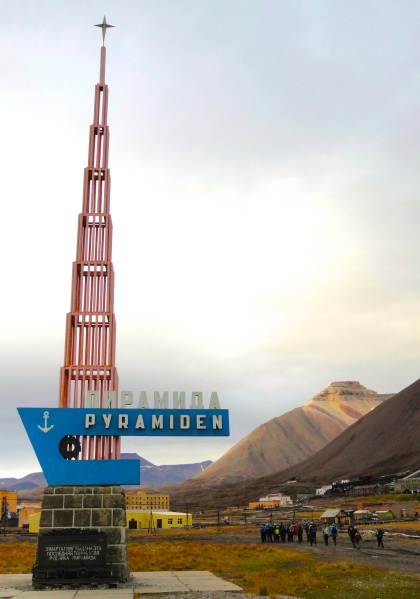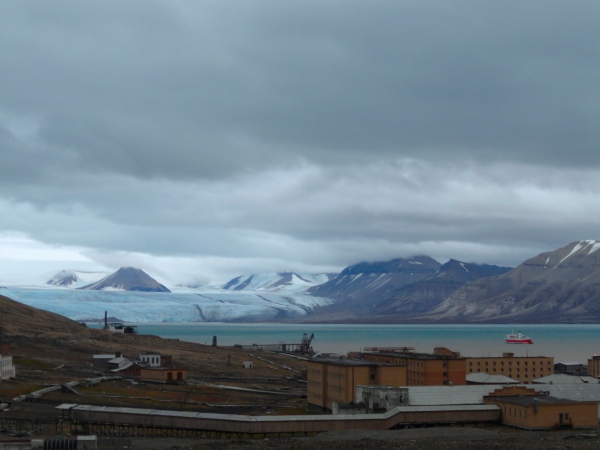One day, we stopped in the nearly abandoned Russian mining town of Pyramiden. Named after pyramid-shaped mountains nearby, the town used to bustle with more than 1000 permanent residents. But it was abandoned in 1998, a few years after a terrible plane crash in Longyearbyen killed 141 on their way to the settlement.

According to our Norwegian guides, miners and their families used to rotate in and out of Pyramiden on two-year shifts. The plane that crashed in 1996 was carrying the group for the next 2 year rotation. We were told that those already in Pyramiden spent an additional 2 years there after the crash and then the town was quickly abandoned in 1998.
This summer, only 17 people live in Pyramiden and only 2 will stay through the winter. The residents’ task is to maintain and clean up the town, which seemed to largely include fending off possible looters and inconsiderate tourists.
We landed near the pier at Pyramiden and then proceeded as a group through town. The pier itself took me back to my Lincoln Log days. As you can imagine, other parts of it were in less good shape. Standing around on shore waiting for all the boats to arrive, one of the geology faculty members pointed out that there was a lot of garnet laying on the ground amidst the gravel. I brought some home as a testament to the fact that I can now identify garnet. Oh, geology.
I was very curious to meet some of the residents of the town; people I imagined to be hardy mountain men with Russian accents. As we were waiting for the rest of the group to arrive on zodiacs, a few passed us wearing all black and carrying rifles. They were surprisingly clean-cut for living in a ghost town in the middle of nowhere.
As they got past us I saw that they were just as curious of us as we were of them. One of them even turned around to get a picture when he was sufficiently past us.
The outskirts of town looked nothing short of war-torn. Rubble lay everywhere and some buildings looked burned and gutted. Large stretches of land between the main part of town and the pier where we landed were barren.
The road was intact, though, and so we started walking toward the main mass of buildings. To my surprise, we soon found out that the road was intact for a reason: how else would the public bus system run?
That’s right, after only a few minutes we saw a bus come down the road. There were only 2 passengers, both women, but I hadn’t expected to see any vehicles much less a bus looking like it was running its typical route around town. The side of the bus revealed it was owned by Trust Arktikugol, a Russian state-owned mining company. (The sign says Arktikugol Spitsbergen. Good thing I brushed up on my cyrillic before the trip!)
I’m not sure where it was going exactly or why the passengers couldn’t walk there. There was no time to ask, though, because the bus didn’t try too hard to slow down as we moved out of the roadway.
As we got closer to the center of town, the evidence of civilization improved. It was obvious that some buildings had been maintained quite a bitter better than others.
One, the Tulip Hotel, seemed in active use and even had some tulips outside to mark the spot.
Why such buzz around the Tulip Hotel? You didn’t need to know Cyrillic for that one. This particular bar is open from sun-up to sundown in summer and from sundown to sun-up in winter. I’ll let you work out those hours for yourself for a bar at 78 degrees N.
As we continued walking through town, the former culture of Pyramiden shone through the ruins.
An old playground near an apartment building.
A cattle stockade.
A hospital.
A school.
A church.
A power plant.
A sports complex named for Yuri Gagarin, first man to orbit Earth.
All the makings of real life, so close to the North Pole. It was like a game of Sim City (that somebody lost).
There were some quirks, too. For example, Pyramiden is home to the northernmost statue of Lenin. Quite a statement piece.
There was also this building made entirely of glass bottles.
Elevated wooden boardwalks took the place of sidewalks since concrete would crack and fall apart on the shifting permafrost.
Here’s a larger view of the grass I mentioned in the last post. No cows are left to graze, but we were given strict instructions not to walk on it. I would’ve insisted, too, if I’d tediously transplanted grass from thousands of miles away.
And there were signs of modern life, too, like this Norwegian post office sign at the Tulip Hotel.
In fact, we got a little more up close and personal with modern life when we started to break out into groups for our daily geology lessons.
Sasha, complete with rifle, trench coat, and mountain-beard (finally!) was not particularly pleased with the route we’d chosen through town.
Luckily, one of our guards somehow knew him and was able to explain that we were only going a little way and wouldn’t wreck the place.
We finished our trip to Pyramiden with a winding hike up the side of its namesake mountain to see some drill sites and sandstone.

Not sure the sandstone was worth the climb, but not a bad view from up there.
All the while, the coal mine that put Pyramiden on the map could be seen in the background.
Next to it, on the mountain, some large words were spelled out: миру мир.
Peace to the world.



























From what little I know of Svalbard, to me, Pyramiden has the most allure!
LikeLike
Agreed! It was so weird being there and seeing people who were living there. It was even weirder when we got into the main part of town and a lot of the buildings looked well preserved but completely deserted.
LikeLike
Wonderful pictures Gail! What an experience. Where did you learn Cyrillic ?
Tom
LikeLike
Hi Tom. I learned cyrillic with a little help from the internet and the public library!
LikeLike
So, you brought home some garnet; should I see if we still have the rock polisher? Sad about the reason the town was abandoned, but while it was inhabited they had everything they needed including some fantastic views!
LikeLike
Not sure my bit of garnet will look like much by the time it gets out of the rock polisher. But we should resurrect that thing now that I’ve taken to collecting rocks!
LikeLike
Amazing experience, Gail. What must it be like for those 17 people who live there in the summer, and, even more so for the 2 who remain all winter. Thanks so much for sharing it with us.
LikeLike
It really is an interesting place, Meg. I wonder how the people there get chosen. Someone mentioned to me that the people who end up there tend to be a bit on the fringes in normal life, too– the kind who prefer being out in the wilderness as opposed to in a bustling city.
LikeLike
Is it possible for us to talk about the place that you visited, even if it was long ago. If your available and still remember, I’m doing some research on it and trying to piece together something. You would be great help with this investigation, thank you.
LikeLike
Hi Monique, good to hear from you! I’m happy to help. Send me a note on my About page (https://imnotyetdead.wordpress.com/about/) and we can chat over email.
LikeLike
Pingback: Return of the Blog | I'm Not Yet Dead